- Founded in 2022, Namma Yatri aims to improve urban transport in India, prioritising convenience and welfare for drivers and passengers alike.
- At the heart of Namma Yatri’s disruptive approach is a simple yet revolutionary concept: a zero-commission model that ensures 100% of the fare goes directly to the drivers.
- Namma Yatri’s key core values are community-first, emphasising the collaboration of citizens and drivers to create a prosperous, equitable and sustainable environment.
OUR TAKE
In India, an emerging travel tech company, Namma Yatri, is leading a quiet revolution with its unique business model and technology platform. It has come up with a zero-commission model. Namma Yatri is more than just a cab-hailing app, it represents a new concept of mobility, a community-centric, technology-driven, and sustainability-oriented transport ecosystem. This article will delve into how Namma Yatri is reshaping the mobility market in India and globally through its innovative direct-to-driver model, open Beckn protocols, and commitment to digital public infrastructure, and its market impact in a highly competitive industry.
–Elodie Qian, BTW reporter
In the bustling streets of India, a mobility revolution is unfolding. Namma Yatri, a trailblazing ride-hailing company, is not just redefining urban transportation; it’s reimagining what’s possible in a sustainable future. With a commitment to innovation and a zero-commission model that puts drivers first, Namma Yatri is setting the stage for a greener, more equitable tomorrow.
Company overview
Namma Yatri is an innovative mobile application that provides transport services for auto-tricycles (auto-rickshaw) mainly in India. Moving Tech Innovations Private Limited owns the app.
The app is popular for its user-friendly interface and real-time tracking system. Moreover, Namma Yatri is not just limited to auto-rickshaws, but it also works towards multi-modal transport integration, integrating multiple modes of transport including buses and taxis on a single platform, thereby providing users with a more comprehensive range of travel options.
The story of Namma Yatri began in 2020 when it was just a startup called ‘Yatri’, which found a lack of convenient and reliable auto-tricycle hailing options in the market. Currently, Namma Yatri has expanded to other cities like Chennai and continues to offer zero-commission services on its platform.
This model not only reduces the amount of money paid by the passenger to the driver, but also allows the passenger to pay cash directly to the driver or through UPI, ensuring that the money reaches the driver instantly.
Namma Yatri is more than an app; it’s an attempt to empower the drivers, to build product and technology that is inclusive and help drivers embrace the customer-centric mindset.
Vimal Kumar, CEO and Founder of Juspay
As of February 2024, Namma Yatri has amassed 5 million users and generated $50 million in revenue for drivers.
To further fuel its expansion, Namma Yatri’s parent company, Moving Tech, raised an $11 million funding round in July 2024, which was participated in by investors such as Blume Ventures, Antler, and Google. The funds were primarily used for R&D and product innovation to enhance user experience and competitiveness in the market.
Also read: Who is Bhavish Aggarwal? The urban visionary behind Ola Cabs
The innovative zero-commission model
At the heart of Namma Yatri’s disruptive approach is a simple yet revolutionary concept: a zero-commission model that ensures 100% of the fare goes directly to the drivers. This model flips the traditional ride-hailing script, empowering drivers with full control over their earnings and fostering a sense of ownership and pride in their work.
Namma Yatri is profitable in other ways. For example, the platform charges drivers a subscription fee. Specifically, drivers can opt for a subscription plan with unlimited trips per day at a cost of Rs 25 ($0.3) per day, or a per trip billing at Rs 3.50 ($0.042) per trip, but no more charges after 10 trips. This subscription model helps the platform to still generate some revenue stream without directly profiting from the transaction.
By eliminating the middleman, Namma Yatri has created a direct-to-driver application that is not only fairer but also more efficient. Drivers are no longer just employees but active participants in a business model that values their contribution and respects their livelihood.
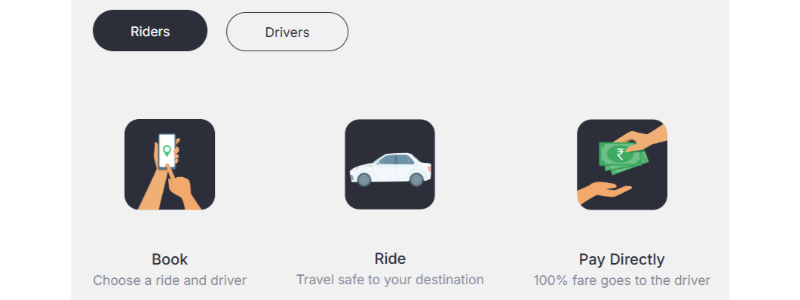
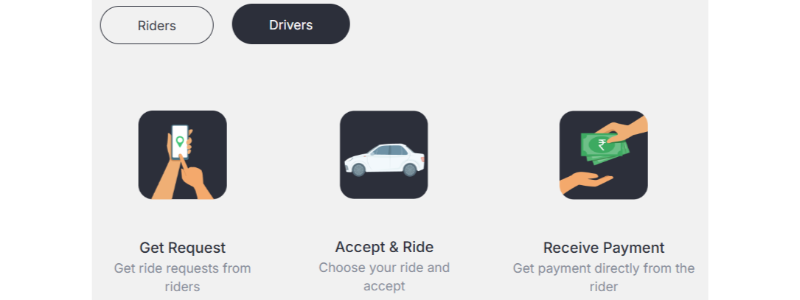
Core values
Namma Yatri’s core values:
- Community-first: Namma Yatri believes that a thriving and equitable mobility ecosystem is a collective effort. The community, including both drivers and citizens, plays a central role in shaping the services and contributing to the development of the platform.
- Citizens as owners: The platform operates on the principle that those who invest in the service—drivers with their vehicles and citizens with their patronage—should have a sense of ownership and benefit directly from the quality service provided at a fair price.
- Open platform: Transparency and open participation are encouraged. Namma Yatri’s data and roadmap are open for community feedback, ensuring a democratic approach to platform development and service improvement.
- Tech and people as enablers: Technology is seen as a tool to make mobility more efficient and reliable. However, the human element is equally important, with empathy and support being key to the success of both drivers and the community.
- Sustainable growth: Namma Yatri is committed to solving long-term mobility challenges sustainably. The company avoids short-term tactics like discounts and incentives, focusing instead on initiatives that are financially, environmentally, and psychologically sustainable.
- Open-source and open data: Embracing the open-source philosophy, Namma Yatri’s platform is built on open data, promoting innovation and collaboration among developers, and ensuring that the platform remains flexible and adaptable to the needs of its users.
- Direct-to-driver model: Namma Yatri has pioneered a model that cuts out middlemen, ensuring that drivers receive the full fare from passengers, which is a testament to the company’s commitment to fair earnings for service providers.
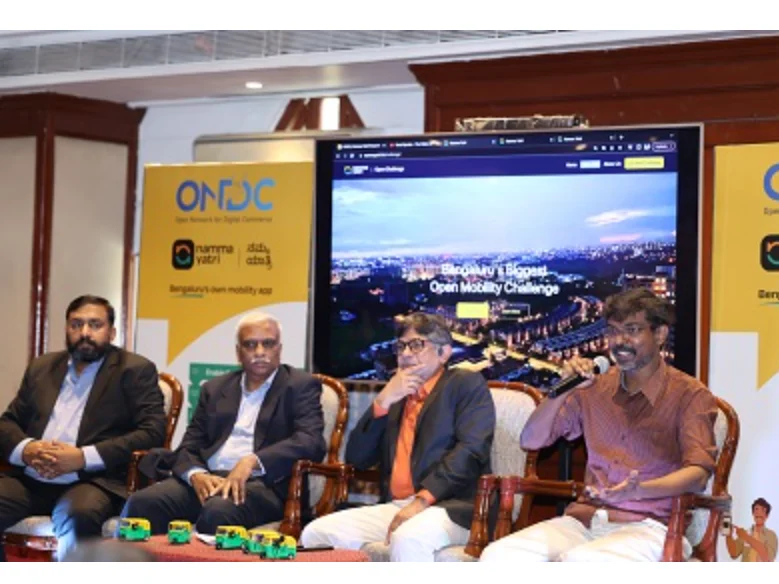
Namma Yatri’s key core values are community-first, emphasising the collaboration of citizens and drivers to create a prosperous, equitable and sustainable environment. The platform is based on the Open Network Digital Trade (ONDC) protocol and is designed to be the ‘UPI’ of transport, i.e. similar to an inter-bank payment system. Namma Yatri has been successful in Bangalore through its partnership with Auto Rickshaw Drivers’ Union and is considered a success story in the ONDC network.
To further promote participatory development to solve large-scale problems, Namma Yatri has also launched Open Mobility Challenges to encourage innovative solutions to mobility problems. These challenges cover a wide range of areas such as the future of mobility, driver empowerment, etc., and aim to attract more developers and innovators to participate through an open platform, thus forming a multi-party collaborative ecosystem.
Also read: India’s Rapido joins unicorn club with $120M funding boost
Beckn protocol: The backbone of innovation
Namma Yatri is built on the robust and open Beckn Protocol, an open-source foundation that fosters a diverse ecosystem for various mobility service providers to coexist and collaborate on a common standard network. This technology not only offers a multi-modal transportation solution to commuters but also ensures transparency and fairness, with the capacity for interoperability between different buyer apps that comply with the network standards.
The Beckn Protocol serves as the backbone of Namma Yatri’s platform, enabling a seamless and direct-to-driver model that eliminates the need for middlemen. This innovative approach ensures that drivers receive the full fare from customers, thereby enhancing their earning potential and providing riders with a cost-effective alternative.
Furthermore, the use of open-source software in Namma Yatri’s application promotes trust and collaboration. The transparency of the open-source code allows for public scrutiny, ensuring the platform’s security and fairness, and encouraging global developers to contribute to the platform’s continuous improvement.
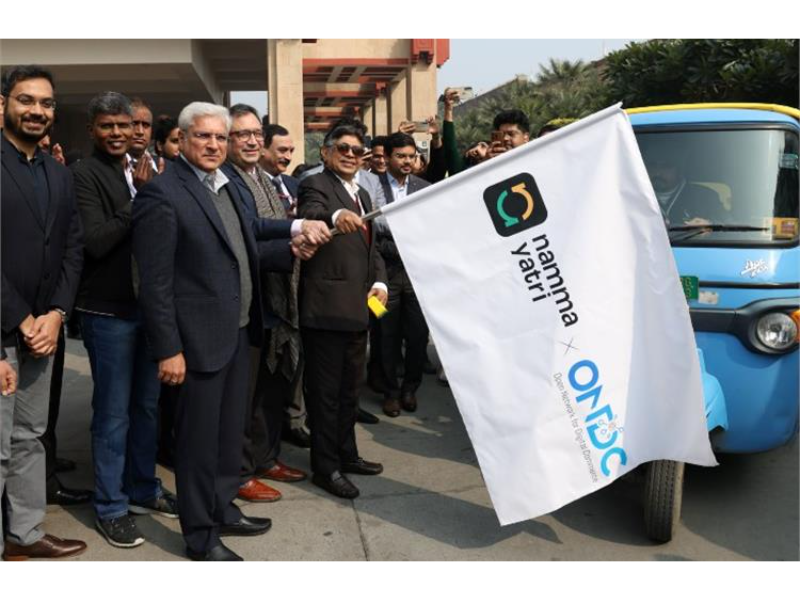
Cooperation model
- Community-driven: Namma Yatri emphasises on a community-driven approach and strengthens ties with the driver community and trade unions through its ‘Community Enablers’ programme to drive expansion of the service to more cities and promote inclusive growth.
- Zero-commission model: Namma Yatri has a subscription-based model instead of the traditional commission-based model. Drivers have the option of paying a fixed daily fee or a per-ride billing plan, thus reducing the financial burden on drivers to some extent.
- Multi-party collaboration: Namma Yatri works with Samaaj (community), Sarkar (government) and Bazaar (business) to build a sustainable future. This multi-party partnership model helps to consolidate resources for wider service coverage and better user experience.

Namma Yatri’s cooperation model is built on the following principles:
- Openness: The platform is open to all service providers who wish to join the network, fostering a diverse and competitive market.
- Interoperability: The Beckn Protocol ensures that different platforms can communicate and transact with each other, creating a seamless user experience.
- Community involvement: Namma Yatri encourages community participation in the development and improvement of the platform, making it a collaborative effort.
- Transparency: By operating on an open network, Namma Yatri ensures that all transactions are transparent, promoting trust among users and service providers.
- Sustainability: The model is designed to be sustainable, focusing on long-term growth and development rather than short-term gains.
Pop quiz:
What funding round did Namma Yatri recently secure to expand its services?
A. A Series A funding round of $5 million
B. A pre-Series A funding round of $11 million
C. A seed funding round of $1 million
D. A Series B funding round of $20 million
The correct answer is at the bottom of the article.
Significant market reach
Namma Yatri is a strong performer in the Indian mobility market, with a significant market presence. Since its inception in November 2022, Namma Yatri has achieved a number of important successes: as of 27 February 2024, the platform has completed 28 million journeys and generated $51.75 million in revenue for drivers.
Since its launch in Bengaluru in November 2023, Namma Yatri has grown to become a ride-hailing service aggregating around 340,000 drivers and over 6 million users, completing more than 120,000 journeys per day. Namma Yatri has managed to capture 25% of the market share from Ola and Uber. This achievement shows that Namma Yatri has demonstrated strong competitiveness in a highly competitive market environment.
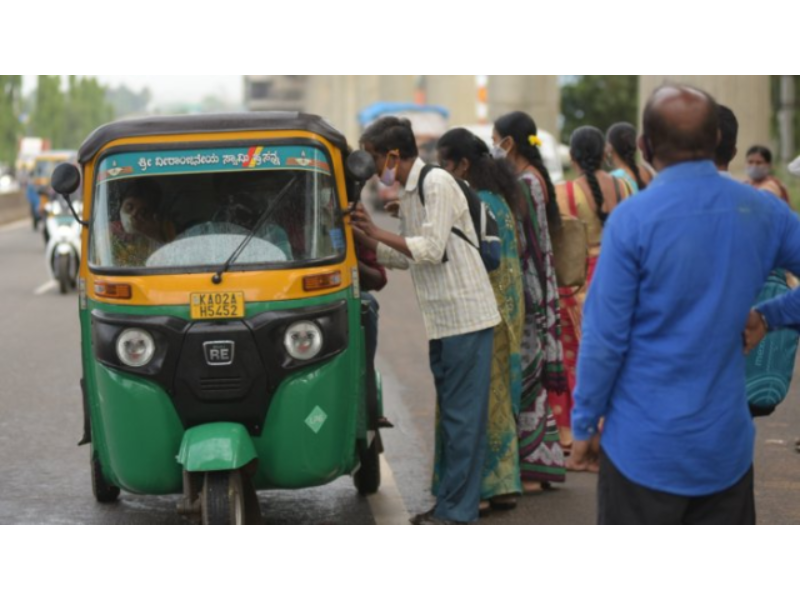
User feedback and market acceptance
The user feedback and market acceptance of Namma Yatri can be gauged somewhat from its ratings. Namma Yatri has a rating of 8/10 on the Android platform and 8/10 on the iPhone platform. This suggests that the majority of users are positive about the app, giving it a high rating.
However, it is important to note that these ratings are based on the feedback of only one user and therefore may not be comprehensive or representative. Additionally, the ratings have not been verified by Google Search, which means that these ratings may not have gone through a rigorous validation process.
Nonetheless, from the information available, Namma Yatri has been relatively well received by users and has received high ratings.
The idea is to create a mobility network where consumers will have access to multiple service providers, from individual drivers to those working under different aggregators. The immediate effect of such a network is to end the exorbitant pricing. The long-term impact is the horizantalisation of the market space for all players
An expert who has worked on the Namma Yatri app said.
Key Challenges
Namma Yatri needs to compete with established brands such as Ola, Rapido and Uber, which have captured the majority of the market share. In order to attract more passengers, Namma Yatri will have to offer more attractive services and pricing strategies.
Encouraging more drivers to join the Namma Yatri platform is a key challenge. While the platform has introduced a zero-commission model to attract drivers, further efforts are needed to ensure continued driver engagement and satisfaction.
Namma Yatri, being an open source and open data based mobility solution, requires constant technology updates and maintenance to keep it competitive.
The road ahead: Expansion and evolution
As Namma Yatri continues to grow, its sights are set on expanding its services, deepening its technological capabilities, and reaching new markets. The company’s future plans include not only geographic expansion but also the introduction of new features and services that will further cement its position as a leader in sustainable mobility.
Conclusion: A sustainable revolution in motion
Namma Yatri is more than a company; it’s a movement. It’s a testament to the power of innovation, the importance of sustainability, and the potential for technology to transform lives. As we look to the future, Namma Yatri stands as a beacon of hope, proving that business and social responsibility can not only coexist but also thrive together.
With its zero-commission model, commitment to sustainability, and innovative use of technology, Namma Yatri is revolutionising India’s mobility for a sustainable future. It’s a journey worth joining, and a revolution that’s just getting started.
The correct answer is B, A pre-Series A funding round of $11 million.
